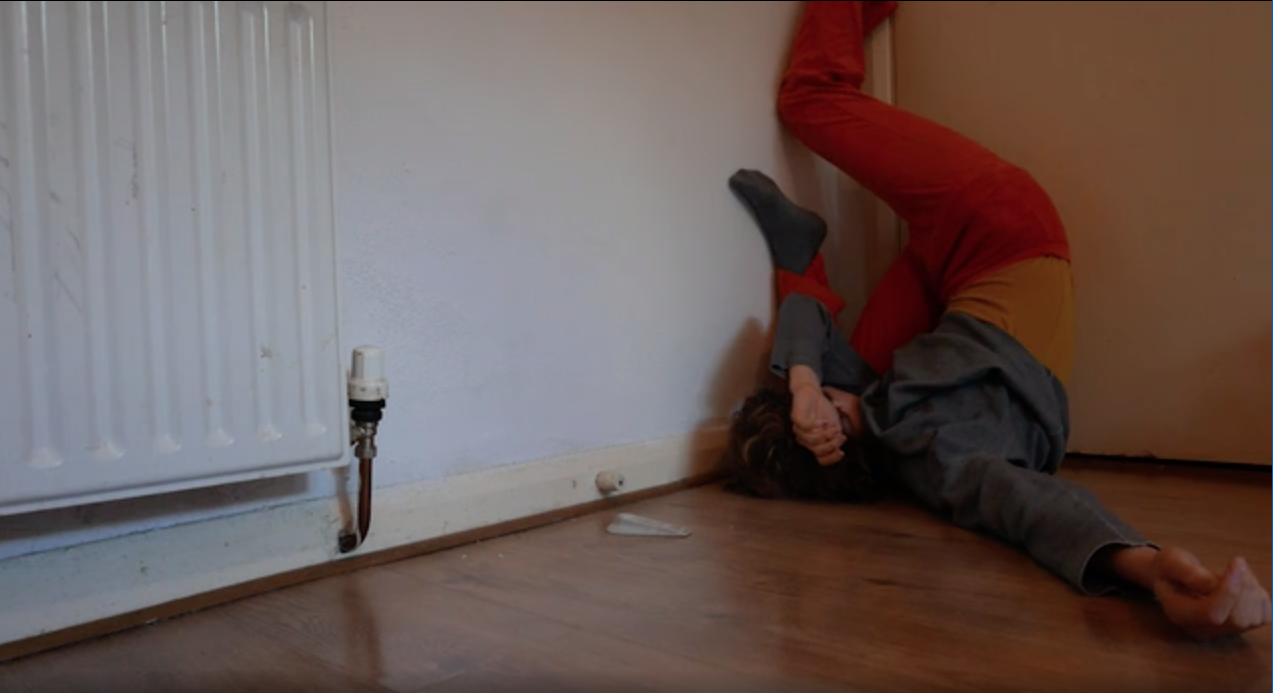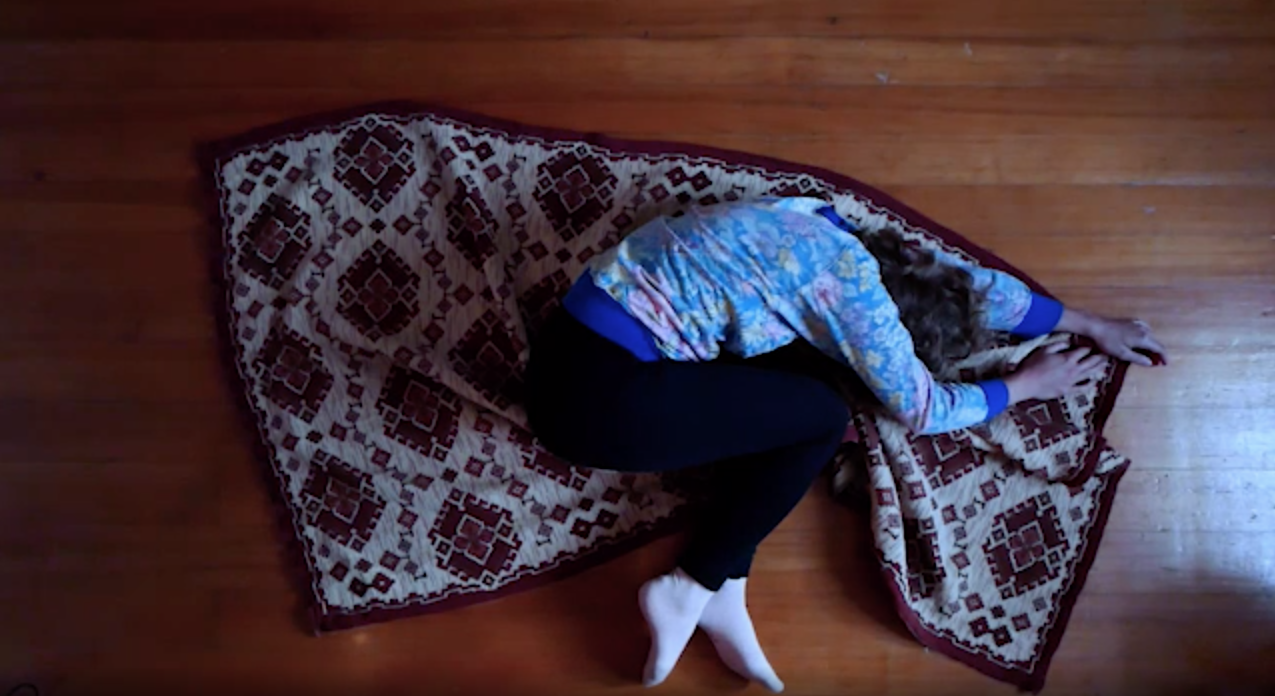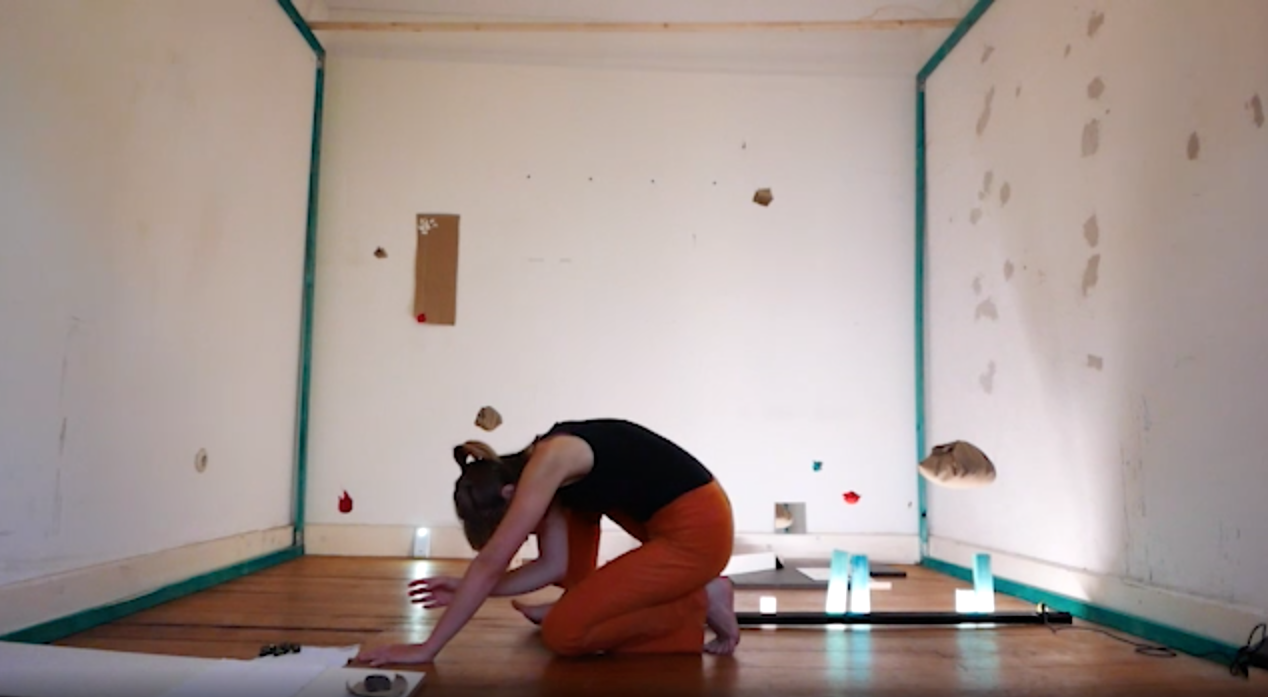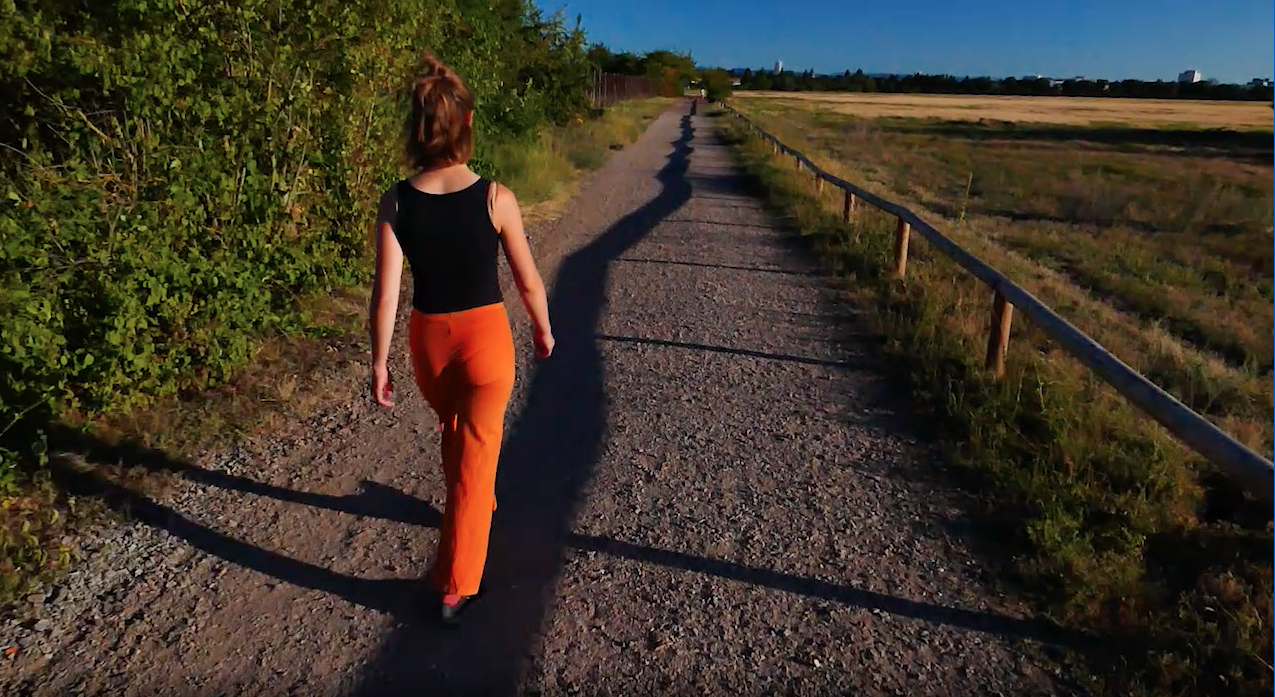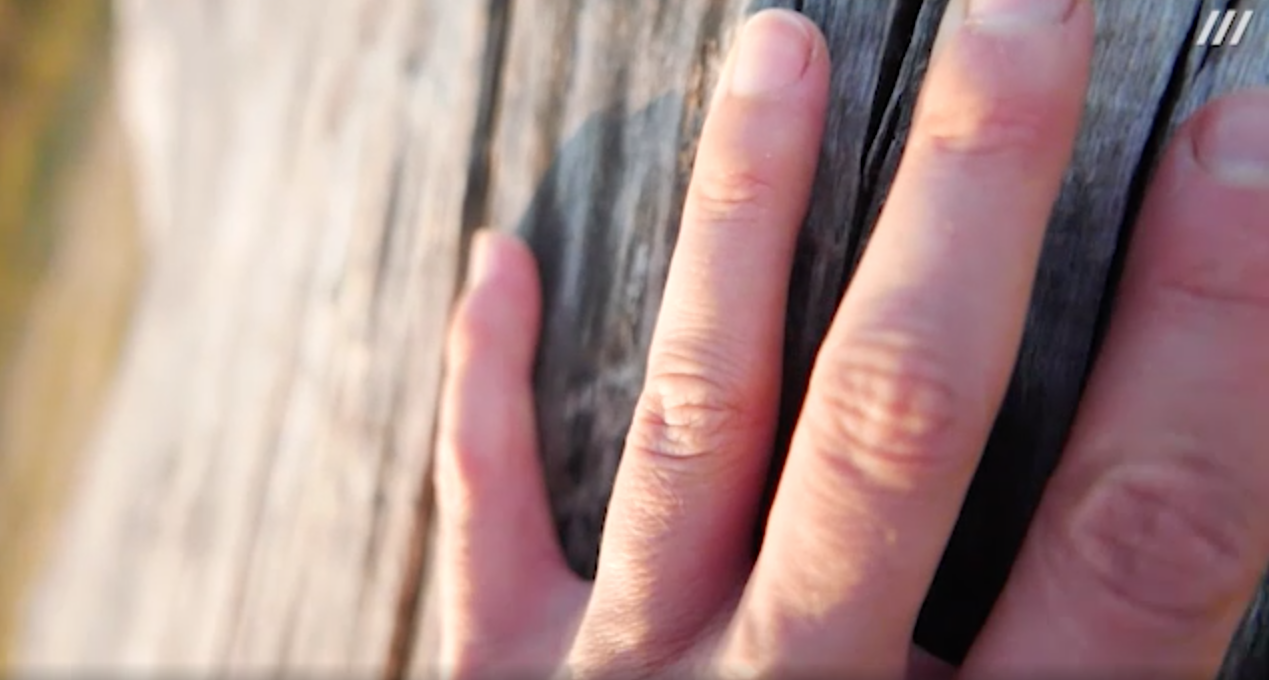The Terrestrial and Improvisation Practices
a reflection on a movement-based research by Mira Hirtz
Localisation: inside the landscape
We enter the museum space at ZKM into the Critical Zones exhibition. The first sight is an installation by Alexandra Arènes and Soheil Hajmirbaba, offering its diverse parts: video screens, sculptural elements, diagrams and maps present the landscape where the Strengbach Critical Zone Observatory is located in. Arènes’ and Hajmirbaba’s »Critical Zone Observatory Space« (2018–2020) constructs an abstraction of landscape and territory that challenges the common ways of representation, such as landscape painting, photography maps etc. that show living beings and matter as fixed entities seen from an outside eye. Thereby, it also questions established ways of how to navigate within a territory. Yet it is specific in showing particular scientific processes, collected data and various entities.
According to Bruno Latour, we need to reflect our tools of navigation in the face of climate change. If our planet is incompatible with our globalized economy, how can we land in the Terrestrial space?1 That is, how can we place ourselves in the reality of the territory we are part of? By being abstract and specific at the same time, does the installation follow Latour’s assessment of “two complementary movements that modernization has made contradictory: attaching oneself to the soil on the one hand, becoming attached to the world on the other”?2
How do we experience this reflection, walking through the installation or looking at the online exhibition? Confronted with imagery and scientific graphs, sounds and information, might bodily enactment enhance the idea of two complementary movements?
Method: Improvisation
Following this line of thought, I will reflect on a series of »Performative Video Tutorials« published on the ZKM Website which I developed in 2020.3 Based on the method of movement improvisation, the videos offer a means of practicing these two complementary movements as well as a number of various other aspects of ‘being terrestrial’. In this reflection I will look back at the ideas and tools explored in the videos to distil three aspects of improvisation.
What is improvisation? Rather than being a method to cover up lack of skill, improvisation is a technique. I see specifically movement improvisation as a training to test and bring into play our bodily intelligence which we carry with us all the time. To train it is about being attentive to this internal knowledge and to be available for the intelligences around us. This sounds similar to Latour’s advice to attach oneself to the soil on the one hand and to the world on the other.
What if we take this advice as a score?
First distillation: Scores
A score creates an instruction, so the improvisation has a direction. Just as we don’t know yet how to orientate in the Critical Zone but have a more or less vague direction – to try to become terrestrial – we now have an improvisation with the direction of attachment to the soil and world: we are about to land.
In movement and dance, this notion is close to that of grounding: being aware of gravity and the ground that allow our bodies to rise up. On a somatic level, the contradiction of being focused on a passive, self-centred sensation and to be actively open towards external influences might already be solved by a co-dependency: by intending to ground ourselves we are also rising, moving, lifting – our curiosity can grow by itself.
Video Tutorial #1: On negotiating a place to land: Grounding invites us to:
Feel your weight dropping into the floor. It can be helpful to imagine your skin and muscles becoming soft, melting, being like a sponge. Role a body part gently, attend to the shift of weight, to the sensation of your weight meeting the ground.
When we have found some ground, what do we perceive when looking beyond this patch of soil we are attached to?
Video Tutorial #3: On the perspective of beings: Folding introduces the idea of turning the perception of ourselves and our lifeworld inside out. Instead of gazing down at the Earth, we look out, as part of the Earth, into a folded space:
There are folds within you, too – organs are folded, so they take up less space. What if you look at the world you live in everyday is a dense folded space that is offering space to many inhabitants? We might start to look out of a fold into another. How to measure the distances and densities you are perceiving?
For a moment, let’s imagine to be back wandering through the museum space while looking at the installation. Are we inside or are we on the outside, looking into something? We see screens showing scientists working outdoors in the Strengbach Critical Zone Observatory. If we turn our attention to the specific information given, who and what is happening within this landscape? I have visited the site myself once in deep winter and I wondered immediately how they deal with the always changing and unforeseeable conditions. Are they improvising too?
Marie-Claire Pierret, geochemist at Strengbach Observatory, contradicts this thought: “We sometimes work with expensive and fragile instruments for which we can’t afford to improvise. In that case we have to follow very precise, repetitive and/or scrupulous protocols to ensure the quality of the data."4
And yet, she differentiates that for measuring field parameters, flexible creativity is needed. Her colleague, hydrogeophysicist Nolwenn Lesparre, agrees: “During the conception and the setup of my field experiments, improvisation has a significant role. We have to deal with: the nature of the process we want to capture, the instruments and tools we possess, the people we are, with different ideas/visions, the time we have or we want to dedicate to a specific work and the reality of the field.”5
In these cases, improvisation thus presents itself as a tool for adaption in situations where no complete control is given. In scientific fieldwork just as in artistic movement explorations, we become changing parameters ourselves. We are part of the frame.
Second distillation: Imagination
We often frame the world as a territory that human action is placed in. According to Latour, a shift of view has to include that the framework “participates in that action. […] Space has become an agitated history in which we are participants […].”6
To embody this idea, let us imagine that the landscape we are in is like a frame to enter. The ability to imagine plays a pivotal role in improvising. When we practiced grounding, imagining that our feet melt into the floor can change our perception profoundly. If we imagine that we are part of the world around us which we are used to merely observe, which effect would occur?
In Video Tutorial #5: On being part of the frame: Dwelling another word is used to describe this perspective: dwelling means to take into account a multiplicity of actors which are co-producing the world rather than categorizing “organisms on the one side and an environment on the other”.7
What is your reach, where are you edges? We call that the kinesphere of your body: the space you take up. What is the relation of this structure to the structure you are part of? And where are its edges? Could your structure dwell in this structure?
Nolwenn Lesparre confirms the importance of imagination in his research, stating that “imagination is a great tool to set up experiments but also to interpret our observations. Personally, I need booth times for me to have reflection and let my ideas budding, times of discussion are also often relevant and regularly back and forth exchanges are required.”8
This already hints to the third key aspect of improvisation: a kind of observation that requires a certain length of time. When I asked about time in scientific research, Philippe Ackerer, a hydrologist modeller, replied: “In an ideal world, the researcher should be free and not having any time constraints.”9 But this is not our reality. How do the scientists in Strengbach and how do we nevertheless practice taking our time?
Third distillation: Witnessing
Marie-Claire Pierret remarked: “Regularly I go to sample different streams during the course of a day. I move from one site to another on foot, usually alone. I particularly like those moments when time from one point to another is incompressible. This free time is like a precious interlude in our ever-accelerating professional times. Moreover, waiting allows us to ask ourselves new questions and to be inventive, imaginative and meditative.”10
Maybe we could take this chance to go for a walk. Video Tutorial #4: On the state of flux: traveling through and with practices walking as a simple way to notice and experience that we are in a constant state of flux, a process of adjusting in response to our own anatomies as well as to the material and living forms we are traveling through and with.
But Video Tutorial #6: On urgency: taking time to be productive reflects that things might already be too late, or at least very urgent: Climate change does not wait for us. It calls us to be productive, yet blind efficiency seems to be one of the things that lead us here.
Improvisation requires not only time to practice, it also requires time within the practice itself: time to witness yourself, your own impulses and needs as well as the ones presenting themselves in your surroundings. Might this be true for scientific field work in the Strengbach Observatory as well? Marie-Claire Pierret is convinced, that “in order to understand the natural environment it is essential to feel it: walking on the site, touching the ground, the vegetation, even the tracks of animals, the water flowing, its temperature, its flow speed… Observing how all these parameters vary with time, conditions, seasons…”11
Now we can conclude that, in order for us to be able to improvise and to become terrestrial, we need to remain curious and imaginative. But how to achieve this, as curiosity and imagination take time? Curiosity and imagination demand testing, failing, pausing, reacting. Still, we can practice to wait – even though there seems to be no time, we can practice to take time to be productive.
What if you attend to the timings around you? Things you may already know, can be your teachers. They can remind you that there are many rhythms.
1 Latour, B. 2018. Down to Earth: Politics in the New Climatic Regime. Cambridge, UK Medford, MA: Polity Press.
2 Latour; 2018, p.12.
3 With the support of the UNSECSO City of Media Arts funds Karlsruhe.
4 Marie-Claire Pierret, personal interview, January 2021.
5 Nolwenn Lesparre, personal interview, January 2021.
6 Latour; 2018, p.42.
7 Latour; 2018, p.76.
8 Nolwenn Lesparre, personal interview, January 2021.
9 Philippe Ackerer, personal interview, January 2021.
10 Marie-Claire Pierret, personal interview, January 2021.
11 Marie-Claire Pierret, personal interview, January 2021.
